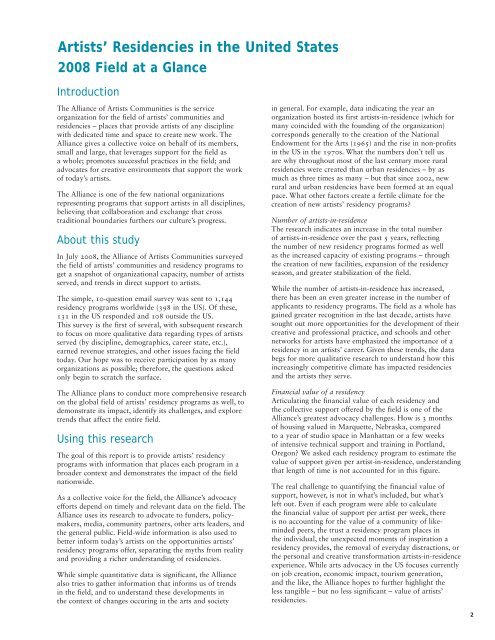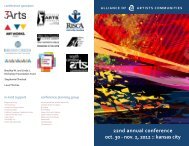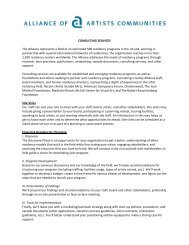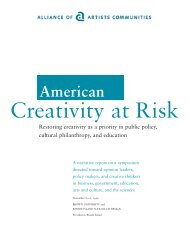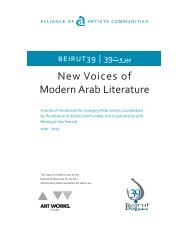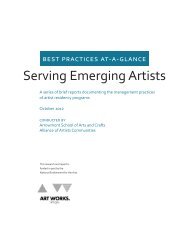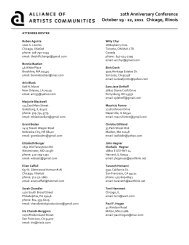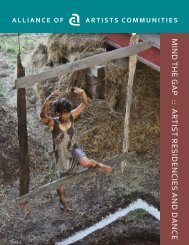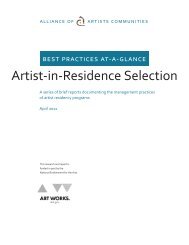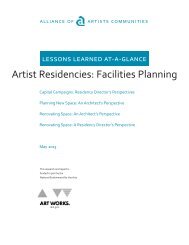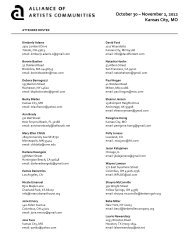Field at a Glance - Alliance of Artists Communities
Field at a Glance - Alliance of Artists Communities
Field at a Glance - Alliance of Artists Communities
You also want an ePaper? Increase the reach of your titles
YUMPU automatically turns print PDFs into web optimized ePapers that Google loves.
<strong>Artists</strong>’ Residencies in the United St<strong>at</strong>es<br />
2008 <strong>Field</strong> <strong>at</strong> a <strong>Glance</strong><br />
Introduction<br />
The <strong>Alliance</strong> <strong>of</strong> <strong>Artists</strong> <strong>Communities</strong> is the service<br />
organiz<strong>at</strong>ion for the field <strong>of</strong> artists’ communities and<br />
residencies – places th<strong>at</strong> provide artists <strong>of</strong> any discipline<br />
with dedic<strong>at</strong>ed time and space to cre<strong>at</strong>e new work. The<br />
<strong>Alliance</strong> gives a collective voice on behalf <strong>of</strong> its members,<br />
small and large, th<strong>at</strong> leverages support for the field as<br />
a whole; promotes successful practices in the field; and<br />
advoc<strong>at</strong>es for cre<strong>at</strong>ive environments th<strong>at</strong> support the work<br />
<strong>of</strong> today’s artists.<br />
The <strong>Alliance</strong> is one <strong>of</strong> the few n<strong>at</strong>ional organiz<strong>at</strong>ions<br />
representing programs th<strong>at</strong> support artists in all disciplines,<br />
believing th<strong>at</strong> collabor<strong>at</strong>ion and exchange th<strong>at</strong> cross<br />
traditional boundaries furthers our culture’s progress.<br />
About this study<br />
In July 2008, the <strong>Alliance</strong> <strong>of</strong> <strong>Artists</strong> <strong>Communities</strong> surveyed<br />
the field <strong>of</strong> artists’ communities and residency programs to<br />
get a snapshot <strong>of</strong> organiz<strong>at</strong>ional capacity, number <strong>of</strong> artists<br />
served, and trends in direct support to artists.<br />
The simple, 10-question email survey was sent to 1,144<br />
residency programs worldwide (398 in the US). Of these,<br />
131 in the US responded and 108 outside the US.<br />
This survey is the first <strong>of</strong> several, with subsequent research<br />
to focus on more qualit<strong>at</strong>ive d<strong>at</strong>a regarding types <strong>of</strong> artists<br />
served (by discipline, demographics, career st<strong>at</strong>e, etc.),<br />
earned revenue str<strong>at</strong>egies, and other issues facing the field<br />
today. Our hope was to receive particip<strong>at</strong>ion by as many<br />
organiz<strong>at</strong>ions as possible; therefore, the questions asked<br />
only begin to scr<strong>at</strong>ch the surface.<br />
The <strong>Alliance</strong> plans to conduct more comprehensive research<br />
on the global field <strong>of</strong> artists’ residency programs as well, to<br />
demonstr<strong>at</strong>e its impact, identify its challenges, and explore<br />
trends th<strong>at</strong> affect the entire field.<br />
Using this research<br />
The goal <strong>of</strong> this report is to provide artists’ residency<br />
programs with inform<strong>at</strong>ion th<strong>at</strong> places each program in a<br />
broader context and demonstr<strong>at</strong>es the impact <strong>of</strong> the field<br />
n<strong>at</strong>ionwide.<br />
As a collective voice for the field, the <strong>Alliance</strong>’s advocacy<br />
efforts depend on timely and relevant d<strong>at</strong>a on the field. The<br />
<strong>Alliance</strong> uses its research to advoc<strong>at</strong>e to funders, policymakers,<br />
media, community partners, other arts leaders, and<br />
the general public. <strong>Field</strong>-wide inform<strong>at</strong>ion is also used to<br />
better inform today’s artists on the opportunities artists’<br />
residency programs <strong>of</strong>fer, separ<strong>at</strong>ing the myths from reality<br />
and providing a richer understanding <strong>of</strong> residencies.<br />
While simple quantit<strong>at</strong>ive d<strong>at</strong>a is significant, the <strong>Alliance</strong><br />
also tries to g<strong>at</strong>her inform<strong>at</strong>ion th<strong>at</strong> informs us <strong>of</strong> trends<br />
in the field, and to understand these developments in<br />
the context <strong>of</strong> changes occuring in the arts and society<br />
in general. For example, d<strong>at</strong>a indic<strong>at</strong>ing the year an<br />
organiz<strong>at</strong>ion hosted its first artists-in-residence (which for<br />
many coincided with the founding <strong>of</strong> the organiz<strong>at</strong>ion)<br />
corresponds generally to the cre<strong>at</strong>ion <strong>of</strong> the N<strong>at</strong>ional<br />
Endowment for the Arts (1965) and the rise in non-pr<strong>of</strong>its<br />
in the US in the 1970s. Wh<strong>at</strong> the numbers don’t tell us<br />
are why throughout most <strong>of</strong> the last century more rural<br />
residencies were cre<strong>at</strong>ed than urban residencies – by as<br />
much as three times as many – but th<strong>at</strong> since 2002, new<br />
rural and urban residencies have been formed <strong>at</strong> an equal<br />
pace. Wh<strong>at</strong> other factors cre<strong>at</strong>e a fertile clim<strong>at</strong>e for the<br />
cre<strong>at</strong>ion <strong>of</strong> new artists’ residency programs?<br />
Number <strong>of</strong> artists-in-residence<br />
The research indic<strong>at</strong>es an increase in the total number<br />
<strong>of</strong> artists-in-residence over the past 5 years, reflecting<br />
the number <strong>of</strong> new residency programs formed as well<br />
as the increased capacity <strong>of</strong> existing programs – through<br />
the cre<strong>at</strong>ion <strong>of</strong> new facilities, expansion <strong>of</strong> the residency<br />
season, and gre<strong>at</strong>er stabiliz<strong>at</strong>ion <strong>of</strong> the field.<br />
While the number <strong>of</strong> artists-in-residence has increased,<br />
there has been an even gre<strong>at</strong>er increase in the number <strong>of</strong><br />
applicants to residency programs. The field as a whole has<br />
gained gre<strong>at</strong>er recognition in the last decade, artists have<br />
sought out more opportunities for the development <strong>of</strong> their<br />
cre<strong>at</strong>ive and pr<strong>of</strong>essional practice, and schools and other<br />
networks for artists have emphasized the importance <strong>of</strong> a<br />
residency in an artists’ career. Given these trends, the d<strong>at</strong>a<br />
begs for more qualit<strong>at</strong>ive research to understand how this<br />
increasingly competitive clim<strong>at</strong>e has impacted residencies<br />
and the artists they serve.<br />
Financial value <strong>of</strong> a residency<br />
Articul<strong>at</strong>ing the financial value <strong>of</strong> each residency and<br />
the collective support <strong>of</strong>fered by the field is one <strong>of</strong> the<br />
<strong>Alliance</strong>’s gre<strong>at</strong>est advocacy challenges. How is 3 months<br />
<strong>of</strong> housing valued in Marquette, Nebraska, compared<br />
to a year <strong>of</strong> studio space in Manh<strong>at</strong>tan or a few weeks<br />
<strong>of</strong> intensive technical support and training in Portland,<br />
Oregon? We asked each residency program to estim<strong>at</strong>e the<br />
value <strong>of</strong> support given per artist-in-residence, understanding<br />
th<strong>at</strong> length <strong>of</strong> time is not accounted for in this figure.<br />
The real challenge to quantifying the financial value <strong>of</strong><br />
support, however, is not in wh<strong>at</strong>’s included, but wh<strong>at</strong>’s<br />
left out. Even if each program were able to calcul<strong>at</strong>e<br />
the financial value <strong>of</strong> support per artist per week, there<br />
is no accounting for the value <strong>of</strong> a community <strong>of</strong> likeminded<br />
peers, the trust a residency program places in<br />
the individual, the unexpected moments <strong>of</strong> inspir<strong>at</strong>ion a<br />
residency provides, the removal <strong>of</strong> everyday distractions, or<br />
the personal and cre<strong>at</strong>ive transform<strong>at</strong>ion artists-in-residence<br />
experience. While arts advocacy in the US focuses currently<br />
on job cre<strong>at</strong>ion, economic impact, tourism gener<strong>at</strong>ion,<br />
and the like, the <strong>Alliance</strong> hopes to further highlight the<br />
less tangible – but no less significant – value <strong>of</strong> artists’<br />
residencies.<br />
2


